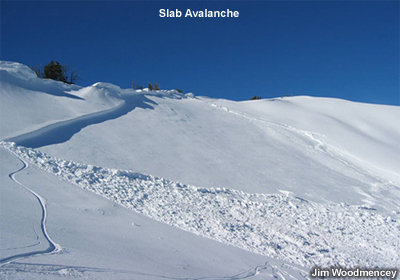Below is a list of of weather hazards that must be considered before snowboarding:
Weakly bonded snow layers in the snowpack:
Remember that it only takes one unstable configuration anywhere in the snowpack to facilitate deadly avalanche conditions. When a stronger, more stable, snow layer lays on top of a weaker layer, an unstable configuration has been created. In particular, facets and buried surface hoar layers can be very dangerous. They can persist for quite a while in the snowpack, and placing any layer of snow on top of them can automatically render a dangerous snowpack. In order to assess the stability of the snowpack, you can dig a snow pit and perform a hand hardness test. I will outline how to perform this in the "Checklist" link.
Reduced Visibility:
Visibility can be reduced by a plethora of weather phenomena, including, but not limited to:
Cold frontal snowfall can reduce visibility. If the snowfall includes blowing snow, visibility can be even further reduced. Blowing snow can be lifted from the ground, or it can be blowing while it is in the air. It is in unpredictable in nature and can in the form of gusts, or it can be more steady. It only takes 14 km/hr to pick the snow off the ground! When blowing snow is very strong, it can make it virtually impossible to open your eyes. This is what blowing snow looks like:

(Wikimedia Commons, https://commons.wikimedia.org/wiki/File:Blowing_snow_over_Langstrandtindan_mountains,_Austvågøya,_Lofoten,_Norway,_2015_April_(8).jpg,Links to an external site. accessed Nov 26, 2018)
Clouds can reduce your visibility both horizontally and vertically. If you find yourself at the same elevation as a cloud, your visibility can be reduced to a point where you can't decipher your shoes on the ground from the snow! This is known as a "white-out" condition and should be avoided.
Example of white-out conditions:

(Unofficial Networks, https://unofficialnetworks.com/2013/09/04/hundreds-trapped-zealands-mt-hutt-ski-resort/,Links to an external site. accessed November 28, 2018)
As a warm front approaches your area, be wary of changing weather conditions. If you are on a hill, you may encounter hazardous flat light. This occurs when sunlight diffuses on the surface of the snow, making it quite difficult to see the snow's texture.
Visibility is especially important if you are planning on snowboarding in the backcountry, where you may not be able to rely on trail signs and markers to guide your path.
Poor visibility conditions can be avoided by checking weather forecasts and satellite imagery before you embark on your trip; these will warn you of upcoming fronts and cloud coverage.
Avalanches:
Avalanches occur when a mass of snow descends a mountain. Loose snow avalanches usually do not cause severe damage, but do have the ability to knock someone over. Slab avalanches are much larger and are associated with greater danger: they can bury a person. When a layer in the snowpack fails and there is a trigger, an avalanche occurs. Triggers can be natural (like new snowfall), or can be humans as well.
Avalanches can be avoided by checking for any pre-existing weak layers in the snowpack (as outlined in the checklist) and checking the Avalanche Forecast before embarking on your trip. A link to an excellent Avalanche Forecast resource is provided in the "Links to Resources" page. Having essential avalanche gear and a decent understanding of the factors that can trigger avalanches can be the difference between life and death.

(UBC ATSC 113, https://www.eoas.ubc.ca/courses/atsc113/snow/met_concepts/07-met_concepts/07j-types-of-avalanche/, accessed Nov 26, 2018)
 icons at the top right corner of the subsection.
icons at the top right corner of the subsection.